Undergraduate, graduate students, postdocs and research scientists along with graduate students affiliated with microbiology labs presented posters during the 2018 Health Sciences Research Week.
Microbiology Graduate Students
Tiffany Borbón | Gwendolyn Clay, Breanna Scorza, Alan Sariol, Yani Chen, Bayan Zhanbolat “Bacterial co-infections in murine cutaneous leishmaniasis" Winner: Iowa City VA Health Care System - Student Category
Matthew Grunewald | Anthony R. Fehr, Alan Sariol, Stanley Perlman “The Aryl Hydrocarbon Receptor is Activated During Coronavirus Infection”
Kai Rogers | Rahul Vijay, Chester Joyner, Mary Galinski, Noah Butler, Wendy Maury “Acute Plasmodium infection promotes resistance to Ebola virus via type 1 immunity” Winner: Carver College of Medicine Graduate - Student Category
Allan Prichard | Laura C. Whitmore, Lee-Ann Allen "Helicobacter pylori infection modulates human neutrophil chemotaxis”
Jennifer Welch | Jinhua Xiang, Patrick M. Schlievert, Chioma M. Okeoma, Jack T. Stapleton “Glycerol Monolaurate (GML), An Analogue to a Factor Secreted by Lactobacillus, is virucidal against enveloped viruses including HIV”
Undergraduate student: Evan Lamb | Michael Trimble, Linda McCarter “Chemotaxis and Surface Colonization in Pathogenic species of Vibrio”
The following are selected reserach descriptions from the following attendees at the 2018 Health Sciences Research Week.
Microbiology Graduate Students
Tiffany Borbón "Bacterial co-infections in murine cutaneous leishmaniasis" 1University of Iowa, 2Cedars-Sinai Medical Center, 3Iowa City Veterans’ Affairs Medical Cente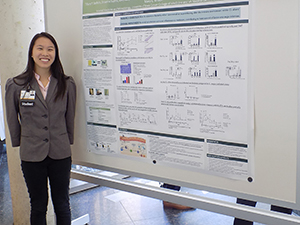 r
r
Matthew Grunewald | Anthony R. Fehr, Alan Sariol, Stanley Perlman “The Aryl Hydrocarbon Receptor is Activated During Coronavirus Infection”
Allan Prichard | Laura C. Whitmore, Lee-Ann Allen "Helicobacter pylori infection modulates human neutrophil chemotaxis”
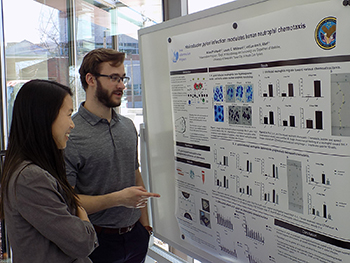
Kai Rogers | Rahul Vijay, Chester Joyner, Mary Galinski, Noah Butler, Wendy Maury “Acute Plasmodium infection promotes resistance to Ebola virus via type 1 immunity”\
Ebola virus ( EBOV) outbreaks occur sporadically in Central and West Africa with case fatality rates as high as 90%. Individuals are often infected with other pathogens endemic to these regions, but consequences of such co-infections are understudied. Epidemiological studies indicate that a significant number of EBOV patients were coinfected with P. falciparum when admitted to Ebola treatment units. Currently, there is no consensus regarding how or whether malaria impacts EBOV infection. Here, we investigated the effect of pre-existing malaria on EBOV challenge.
EBOV) outbreaks occur sporadically in Central and West Africa with case fatality rates as high as 90%. Individuals are often infected with other pathogens endemic to these regions, but consequences of such co-infections are understudied. Epidemiological studies indicate that a significant number of EBOV patients were coinfected with P. falciparum when admitted to Ebola treatment units. Currently, there is no consensus regarding how or whether malaria impacts EBOV infection. Here, we investigated the effect of pre-existing malaria on EBOV challenge.
Jennifer Welch | Jinhua Xiang, Patrick M. Schlievert, Chioma M. Okeoma, Jack T. Stapleton “Glycerol Monolaurate (GML), An Analogue to a Factor Secreted by Lactobacillus, is virucidal against enveloped viruses including HIV”
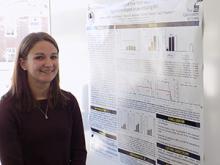
The vaginal microbiota influences HIV sexual transmission. Colonization of the vaginal tract is normally dominated by Lactobacillus. Lactobacillus as well as Enterococcus faecalis secrete reutericyclin, which inhibits a variety of pathogenic bacteria. Increasing evidence suggests a therapeutic role for an analogue to reutericyclin, glycerol monolaurate (GML), against microbial pathogens. Previous studies using a macaque-SIV vaginal transmission model demonstrated that GML reduces transmission, and alters immune responses to infection. We hypothesized that GML may also interfere with HIV replication. We sought to: i) expand understanding of how GML inhibits HIV and ii) evaluate GML antiviral effects on other viruses.
Postdoctoral Scholars/Fellows, Faculty and Staff
Ashley L. Cooney | Brajesh K. Singh, Laura Marquez Loza, Ian M. Thornell, Linda S. Powers, Camilla E. Hippee “Widespread airway distribution and phenotypic correction of cystic fibrosis pigs following aerosol delivery of piggy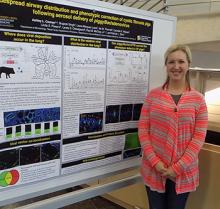 Bac/Adenovirus”
Bac/Adenovirus”
Cystic fibrosis (CF) is a common genetic disease affecting multiple organ systems. Chronic bacterial infections and inflammation in the lung are the leading cause of morbidity and mortality in CF patients. CF is caused by mutations in a gene coding for an anion channel, cystic fibrosis transmembrane conductance regulator (CFTR). Delivery of a functional CFTR gene complements this defect. Our goal is to provide a life-long gene replacement strategy that would be efficacious regardless of the 2000 potential disease-causing mutations.
Kayley H. Janssen | J.T. Cribbs, Deven Voelker, Zachary Slusher, Barbara I. Kazmierczak, Timothy L. Yahr “Regulation of Pseudomonas aeruginosa type III secretion system by small non-coding sRNAs”
Corey Parlet | Alexander Horswill, Mary Wilson “Enhanced neutrophil effector responses conferring protective anti-MRSA immunity correspond with CD4+ T cell expansion in the skin and germinal center B cell formation in the skin draining lymph nodes” Winner: Iowa City VA Health Care System Staff and Postdoctoral Fellows Category
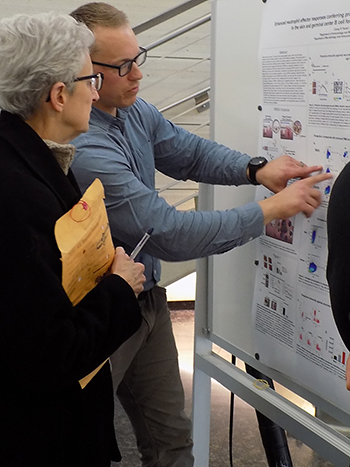 Staphylococcus aureus (S. aureus) is the single greatest cause of skin and soft tissue infections, which are often a prelude to invasive, life-threatening disease. The development of both drug-resistance and hyper-virulence are typifying features of methicillin-resistant S. aureus (MRSA) strains that have inflicted pandemic disease in healthy populations. Both clinical and experimental evidence suggest that neutrophils (PMNs) are essential mediators of anti-S. aureus host-defense and that the enhanced capacity of emerging MRSA strains to unleash PMN killing toxins accounts for their
Staphylococcus aureus (S. aureus) is the single greatest cause of skin and soft tissue infections, which are often a prelude to invasive, life-threatening disease. The development of both drug-resistance and hyper-virulence are typifying features of methicillin-resistant S. aureus (MRSA) strains that have inflicted pandemic disease in healthy populations. Both clinical and experimental evidence suggest that neutrophils (PMNs) are essential mediators of anti-S. aureus host-defense and that the enhanced capacity of emerging MRSA strains to unleash PMN killing toxins accounts for their 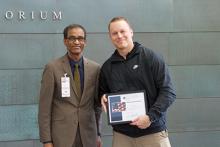 ability to overwhelm host-defense responses and transmit disease among immune-competent populations. Using a MRSA challenge model that elicits protective immunity against recurrent MRSA skin infection, we show that the protection afforded to previously infected “immunized” mice, corresponds with a ten-fold increase in the accumulation of phagocytic PMNs at infectious foci. Suggesting that skin T cells contribute to enhanced PMN responses in immune mice, primary S. aureus infection prompts TH17 cell influx into infected skin and durably elevates total CD4+ T cells numbers throughout the tissue well into memory time points (>8wks). Supporting a role for B cell participation in anti-MRSA cutaneous immunity, primary infection robustly induces germinal center B cells in the skin draining lymph nodes and affords protection from dermonecrotic injury after sterile challenge with MRSA toxins. These findings provide new information about the adaptive T and B cell correlates of anti-MRSA protective immunity and suggest that the appropriate induction of humoral and cellular immune responses can separately but synergistically support anti-MRSA PMN activity and bolster host-defense.
ability to overwhelm host-defense responses and transmit disease among immune-competent populations. Using a MRSA challenge model that elicits protective immunity against recurrent MRSA skin infection, we show that the protection afforded to previously infected “immunized” mice, corresponds with a ten-fold increase in the accumulation of phagocytic PMNs at infectious foci. Suggesting that skin T cells contribute to enhanced PMN responses in immune mice, primary S. aureus infection prompts TH17 cell influx into infected skin and durably elevates total CD4+ T cells numbers throughout the tissue well into memory time points (>8wks). Supporting a role for B cell participation in anti-MRSA cutaneous immunity, primary infection robustly induces germinal center B cells in the skin draining lymph nodes and affords protection from dermonecrotic injury after sterile challenge with MRSA toxins. These findings provide new information about the adaptive T and B cell correlates of anti-MRSA protective immunity and suggest that the appropriate induction of humoral and cellular immune responses can separately but synergistically support anti-MRSA PMN activity and bolster host-defense.
Kyp L. Oxley | Brett M. Hanson, Laura L. Stunz, Ashley N. Zani, Gail A. Bishop “B lymphocytes as antigen-presenting cell vaccines for tumor immunotherapy”
Stina L. Urban | Lecia L. Pewe, John T. Harty “CD8 T cells are recruited to the central nervous system after peripheral infections and adopt a tissue resident memory phenotype”
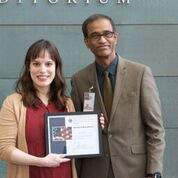 Laura Whitmore | Stephanie Silva-Del Toro, Megan Weems, Lee-Ann Allen “Helicobacter pylori modulates the lifespan and cell death mechanisms of human neutrophils” Winner; Iowa City VA Health Care System Staff and Postdoctoral Fellows Category
Laura Whitmore | Stephanie Silva-Del Toro, Megan Weems, Lee-Ann Allen “Helicobacter pylori modulates the lifespan and cell death mechanisms of human neutrophils” Winner; Iowa City VA Health Care System Staff and Postdoctoral Fellows Category
The following are graduate students who presented posters and work in microbiology affiliated labs:
Tina Arkee | Gail Bishop “TRAF3-mediated regulation of the T cell receptor complex”
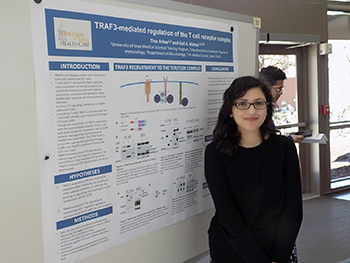 TRAF3 is an adaptor protein with diverse cell type and context-specific functions. Our laboratory has shown that TRAF3 plays an important role in T cell biology and function. In T cell conditional TRAF3-/- mice, T cells exhibit diminished survival, increased apoptosis, and decreased cytokine production, and the mice display poor responses to immunization and infection. In vitro, T cell receptor (TCR) signaling is defective in TRAF3-deficient T cells. We recently reported that TRAF3 inhibits localization of the negative regulators Csk and PTPN22 to the TCR.TRAF3 associates with the TCR-CD28 complex upon stimulation; engagement of both the TCR and CD28 is required for TRAF3 recruitment. We hypothesize that TRAF3 associates with the TCR complex either indirectly, by binding to other adaptor proteins, or directly, by binding to motifs present in the cytoplasmic tail of CD28. Preliminary experiments suggest that the TRAF3 TRAF-C domain associates with Linker of Activated T cells (LAT), but not with the LAT-binding adaptor protein Gads. We are investigating the structural requirements for the association of TRAF3 with CD28, the adaptor protein Grb2, and other TCR signaling proteins, to determine how TRAF3 is recruited to the TCR complex.
TRAF3 is an adaptor protein with diverse cell type and context-specific functions. Our laboratory has shown that TRAF3 plays an important role in T cell biology and function. In T cell conditional TRAF3-/- mice, T cells exhibit diminished survival, increased apoptosis, and decreased cytokine production, and the mice display poor responses to immunization and infection. In vitro, T cell receptor (TCR) signaling is defective in TRAF3-deficient T cells. We recently reported that TRAF3 inhibits localization of the negative regulators Csk and PTPN22 to the TCR.TRAF3 associates with the TCR-CD28 complex upon stimulation; engagement of both the TCR and CD28 is required for TRAF3 recruitment. We hypothesize that TRAF3 associates with the TCR complex either indirectly, by binding to other adaptor proteins, or directly, by binding to motifs present in the cytoplasmic tail of CD28. Preliminary experiments suggest that the TRAF3 TRAF-C domain associates with Linker of Activated T cells (LAT), but not with the LAT-binding adaptor protein Gads. We are investigating the structural requirements for the association of TRAF3 with CD28, the adaptor protein Grb2, and other TCR signaling proteins, to determine how TRAF3 is recruited to the TCR complex.
Alan Sariol | Stanley Perlman “Regulatory T Cell Memory in Mouse Hepatitis Virus Infection”
Though microglia are thought to be the resident macrophages of the central nervous system, their role in viral infections is not well understood. Microglia are dependent on CSF1R signaling for differentiation, proliferation, and 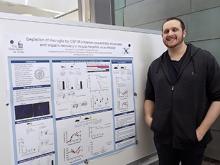 survival. Dietary administration of a specific inhibitor of CSF1R tyrosine-kinase activity, PLX5622, allows near-complete depletion of microglia while leaving peripheral macrophage and other leukocyte populations numerically intact. Mice infected with the neuroattenuated rJ2.2 strain of the murine coronavirus, mouse hepatitis virus (MHV), develop acute encephalitis as well as acute and chronic demyelinating diseases. Depletion of microglia at early time points relative to infection results in complete lethality and elevated viral titers in the brain.
survival. Dietary administration of a specific inhibitor of CSF1R tyrosine-kinase activity, PLX5622, allows near-complete depletion of microglia while leaving peripheral macrophage and other leukocyte populations numerically intact. Mice infected with the neuroattenuated rJ2.2 strain of the murine coronavirus, mouse hepatitis virus (MHV), develop acute encephalitis as well as acute and chronic demyelinating diseases. Depletion of microglia at early time points relative to infection results in complete lethality and elevated viral titers in the brain.
In order to assess the role of microglia in the immune-mediated demyelinating disease that develops later in infection and the subsequent remyelination and recovery process, mice were treated with PLX5622 beginning at 7 or 10 days post-infection. Depletion of microglia beginning at these later time points resulted in exacerbated demyelinating disease, evidenced by increased clinical scores and weight loss, as well as an impaired recovery and remyelination process relative to untreated mice.
Together, these data suggest that microglia play a critical role both in mounting a protective immune response to viral encephalitis and in limiting immune-mediated demyelination or promoting remyelination and recovery.
Stephanie L. Silva-Del Toro | Laura Whitmore, Lee-Ann Allen “Mechanisms of H. pylori-Induced Neutrophil Nuclear Hypersegmentation”
Amy Whillock | Nurbek Mambetsariev1, Wai Lin, Laura Stunz, Gail Bishop “TRAF3 regulates Pim2 and c-Myc-mediated B cell survival”
Tumor necrosis factor receptor associated factor 3 (TRAF3) is an adaptor protein that plays an important role in B cell homeostasis. TRAF3 deletions or inactivating mutations are common in human B cell malignancies. In human and mouse B cells, TRAF3 negatively regulates signaling of several receptors important for B cell homeostasis (including BAFFR, CD40, and IL-6R). B cell specific TRAF3-deficient (B-Traf3-/-) mice have enlarged spleens and lymph nodes and an increased frequency of B cell tumors as they age. B cells from B-Traf3-/- mice have markedly increased survival and autoantibody production. The mechanisms by which TRAF3 regulates B cell survival are not yet well defined. We found that TRAF3-deficient mouse B cells and human multiple myeloma cell lines with low expression of TRAF3 had increased RNA and protein expression of the pro-survival kinase Pim2. Additionally, TRAF3-deficient mouse B cells had increased phosphorylation of Pim2 targets BAD, p70S6K, and 4E-BP1. TRAF3-deficient B cells showed increased survival relative to TRAF3-sufficient B cells after treatment with the
Pim inhibitors SGI-1776 and TP-3654. Pim2 can promote survival by phosphorylating and stabilizing the oncogenic transcription factor c-Myc. Loss of TRAF3 led to transcription-independent c-Myc protein elevation that was dependent on Pim2. K48 polyubiquitination of c-Myc was decreased in the absence of TRAF3, consistent with increased c-myc protein stability. TRAF3 deficiency correlated with B cell resistance to apoptosis mediated by the c-Myc transcription inhibitor JQ1. Our results show that TRAF3 promotes B cell survival by regulating expression of and interaction between Pim2 and c-Myc.